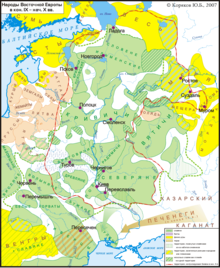Krivichs
This article needs additional citations for verification. (December 2017) |


The Krivichs or Kryvichs (
In some variants of Belarusiphile
Etymology
Many historians suggest that the name of the tribe probably stems from that of their legendary forefather Kriv, possibly a
History
The Krivichs left many archaeological monuments, such as the remnants of agricultural settlements with traces of ironworks, jeweler's art, blacksmith's work and other handicrafts; long burial mounds of the 6th to 9th centuries with cremated bodies; burial mounds of rich warriors with weapons; sets of distinctive jewelry (bracelet-like temporal rings and glass beads made out of stretched wire). By the end of the first millennium, the Krivichs had already had well-developed farming and cattle-breeding. Having settled around the
The Krivichs as a tribe took part in
Modern uses of the name
- Today, in Latvian, Krievs means "Russian" and Krievija is "Russia". Through Baltic territories, the word became known in Central Europe. For example, a German chronicler from Duisburg wrote in 1314: "Frater Henricus Marschalcus... venit ad terram Crivitae, et civitatem illam, quae parva Nogardia dicitur cepit". And in a Polish publication Kazanie na Pogrzeb Maryanny Korsakywnej (Lublin, 1687. Б. II, 49) the Polotsk saint Paraxedis was called Regina Krivitae (the queen of the Kryvians).
- Also in Latvian, a Belarusian is known as Baltkrievs, and Belarus is named Baltkrievija. The prefix balt- is from the Latvian word balts which means "white", thus Baltkrievija is cognate to "White Russia" and "Belarus" itself.
- Kryvich (Крывіч) was the name of a magazine that the Belarusian historian Vaclau Lastouski published in Kaunas from 1923 to 1927.
- Kriwi is the name of a Belarusian folk-rock band.
- Places named Kryvičy in modern Belarus are possibly named after the tribe, however this is contested basing on the suggested areal of Krivichs.[5]
See also
- List of Medieval Slavic tribes
References
- ISBN 9780313274978.
- ^ "Становление культуры псковских длинных курганов".
- ISBN 9788677431044.
- )
- ^ Ежы Ахманскі. Літоўская этнічная мяжа на ўсходзе ад племянной эпохі да XVI стагоддзя // ARCHE 2 2016. С. 13—96.
